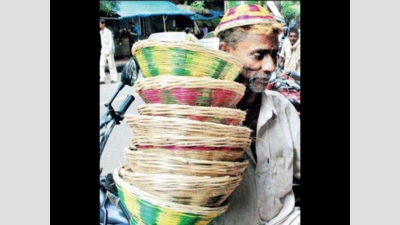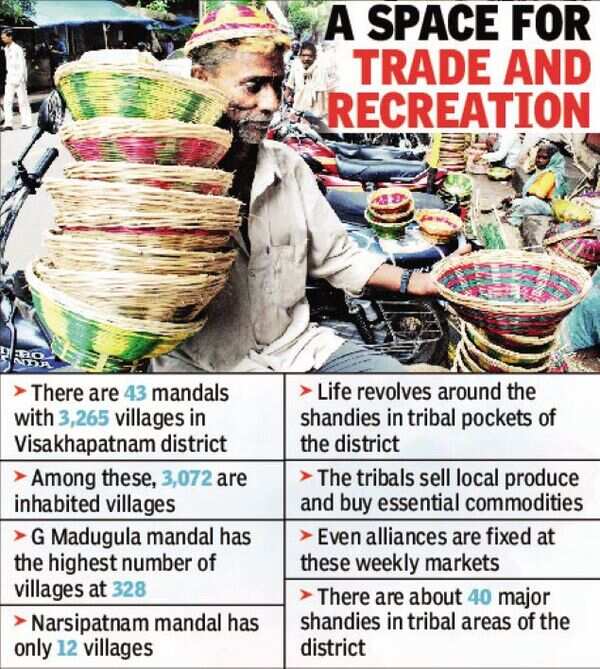- News
- City News
- visakhapatnam News
- Weekly shandies central in tribal heart of Vizag district
Trending
This story is from July 8, 2021
Weekly shandies central in tribal heart of Vizag district
As many as 776 villages and hamlets are dependent on weekly shandies in Visakhapatnam district. This is the second highest in the country, followed by Mayurbhanj district in Odisha with 937 villages, as per an analysis done on the Mission Antyodaya 2019 data by India Data Portal, an open data-driven initiative of the Bharati Institute of Public Policy of the Indian School of Business (ISB).

A SPACE FOR TRADE AND RECREATION
VISAKHAPATNAM: As many as 776 villages and hamlets are dependent on weekly shandies in Visakhapatnam district. This is the second highest in the country, followed by Mayurbhanj district in Odisha with 937 villages, as per an analysis done on the Mission Antyodaya 2019 data by India Data Portal, an open data-driven initiative of the Bharati Institute of Public Policy of the Indian School of Business (ISB).
As per the IDP’s analysis, about 95,000 villages in the country have weekly haats.There is a higher concentration of weekly haats in states like Uttar Pradesh, Bihar, Odisha and Jharkhand.

Even though these weekly markets are held in several rural areas of Visakhapatnam district, the weekly shandies serve as the nerve centre of the economy in the tribal pockets. People from the hilly regions of Araku and Paderu descend and trek for miles to reach these shandies every week.
K Govinda Rao, CPM leader from Araku, said: “In the absence of organised malls or regular mandis in the remotest tribal hamlets, the forest dwellers would depend on the shandies for the direct sale of minor local produce such as tamarind, gum, hill brooms, honey, adda leaves, firewood, etc. and vegetables and fruits. In turn, they would purchase essential commodities drawn from the plain areas of the district. Even poultry and cattle would be available in some weekly markets. Barter system is also practised in some places,” said Govinda Rao.
Govinda Rao added that there are 41 weekly shandies in the tribal areas of the district. “For instance, there are two weekly haats in Ananthagiri mandal, including Damuku and Kasipatnam. The weekly haat is held in Sunkaramettah on Sundays. Likewise, shandies are held in Pedabayalu, Anantagiri Lambasingi, Majjigaruvu, Araku, Darakonda, Downuru, Kinchumanda, Paderu, Hukumpeta, Kasipatnam and Munchingput on different days of the week. Over the years, the infrastructure at the shandies has improved. Each shandy attracts people from tens of nearby hamlets. It is a melting pot for tribals scattered in the hilly region and for socialisation,” said Govinda Rao.
The India Data Portal report added that economic growth in India is mostly demand-driven. “Due to the Covid-19 pandemic, where the growth shows a downward trend, the weekly haats may help contribute to growth recovery through its rural demand generating capacity,” read the report.
As per the IDP’s analysis, about 95,000 villages in the country have weekly haats.There is a higher concentration of weekly haats in states like Uttar Pradesh, Bihar, Odisha and Jharkhand.

Even though these weekly markets are held in several rural areas of Visakhapatnam district, the weekly shandies serve as the nerve centre of the economy in the tribal pockets. People from the hilly regions of Araku and Paderu descend and trek for miles to reach these shandies every week.
Apart from the sale or buying of agricultural commodities and other local produce, these markets provide a space for social and cultural interaction and recreational activities.
K Govinda Rao, CPM leader from Araku, said: “In the absence of organised malls or regular mandis in the remotest tribal hamlets, the forest dwellers would depend on the shandies for the direct sale of minor local produce such as tamarind, gum, hill brooms, honey, adda leaves, firewood, etc. and vegetables and fruits. In turn, they would purchase essential commodities drawn from the plain areas of the district. Even poultry and cattle would be available in some weekly markets. Barter system is also practised in some places,” said Govinda Rao.
Govinda Rao added that there are 41 weekly shandies in the tribal areas of the district. “For instance, there are two weekly haats in Ananthagiri mandal, including Damuku and Kasipatnam. The weekly haat is held in Sunkaramettah on Sundays. Likewise, shandies are held in Pedabayalu, Anantagiri Lambasingi, Majjigaruvu, Araku, Darakonda, Downuru, Kinchumanda, Paderu, Hukumpeta, Kasipatnam and Munchingput on different days of the week. Over the years, the infrastructure at the shandies has improved. Each shandy attracts people from tens of nearby hamlets. It is a melting pot for tribals scattered in the hilly region and for socialisation,” said Govinda Rao.
The India Data Portal report added that economic growth in India is mostly demand-driven. “Due to the Covid-19 pandemic, where the growth shows a downward trend, the weekly haats may help contribute to growth recovery through its rural demand generating capacity,” read the report.
End of Article
FOLLOW US ON SOCIAL MEDIA










